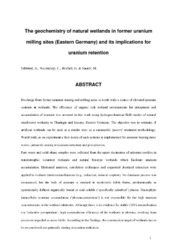Geochemistry of natural wetlands in former uranium milling sites (eastern Germany) and implications for uranium retention
Preprint2008
DOI: https://doi.org/10.1016/j.chemer.2007.12.003
Persistent URL: http://resolver.sub.uni-goettingen.de/purl?gldocs-11858/7081
Persistent URL: http://resolver.sub.uni-goettingen.de/purl?gldocs-11858/7081
Schöner, Angelika; Noubactep, Chicgoua; Büchel, Georg; Sauter, Martin, 2008: Geochemistry of natural wetlands in former uranium milling sites (eastern Germany) and implications for uranium retention. In: Schöner, Angelika; Noubactep, Chicgoua; Büchel, Georg; Sauter, Martin (2008): Geochemistry of natural wetlands in former uranium milling sites (eastern Germany) and implications for uranium retention, DOI: 10.1016/j.chemer.2007.12.003.
 |
Dokument öffnen: |
Discharge from former uranium mining and milling areas is world wide a source of elevated uranium contents in wetlands. The efficiency of organic rich wetland environments for entrapment and accumulation of uranium was assessed in this work using hydrogeochemical field studies of natural small-sized wetlands in Thuringia and Saxony, Eastern Germany. The objective was to estimate, if artificial wetlands can be used in a similar way: as a sustainable 'passive' treatment methodology. World wide, as an experiment a first dozen of such systems is implemented for uranium bearing mine waters, primarily aiming at uranium reduction and precipitation.
Pore water and solid phase samples were collected from the upper decimetres of substrate profiles in minerotrophic volunteer wetlands and natural fen-type wetlands which facilitate uranium accumulation. Elemental analyses, correlation techniques and sequential chemical extraction were applied to evaluate retention mechanisms (e.g., reduction, mineral sorption). No dominant process was pronounced, but the bulk of uranium is retained in moderately labile forms, predominantly as operationally defined organically bound or acid soluble (‘specifically adsorbed’) phases. Macrophyte intracellular uranium accumulation (‘phytoaccumulation’) is not responsible for the high uranium concentrations in the wetland substrates. Although there is no evidence for stable U(IV) mineralisation via ‘reductive precipitation’, high accumulation efficiency of the wetlands is obvious, resulting from processes regarded as more labile. According to the findings, the construction target of wetlands has to be reconsidered, not primarily aiming at uranium reduction.
Statistik:
ZugriffsstatistikSammlung:
- Geologie [931]

